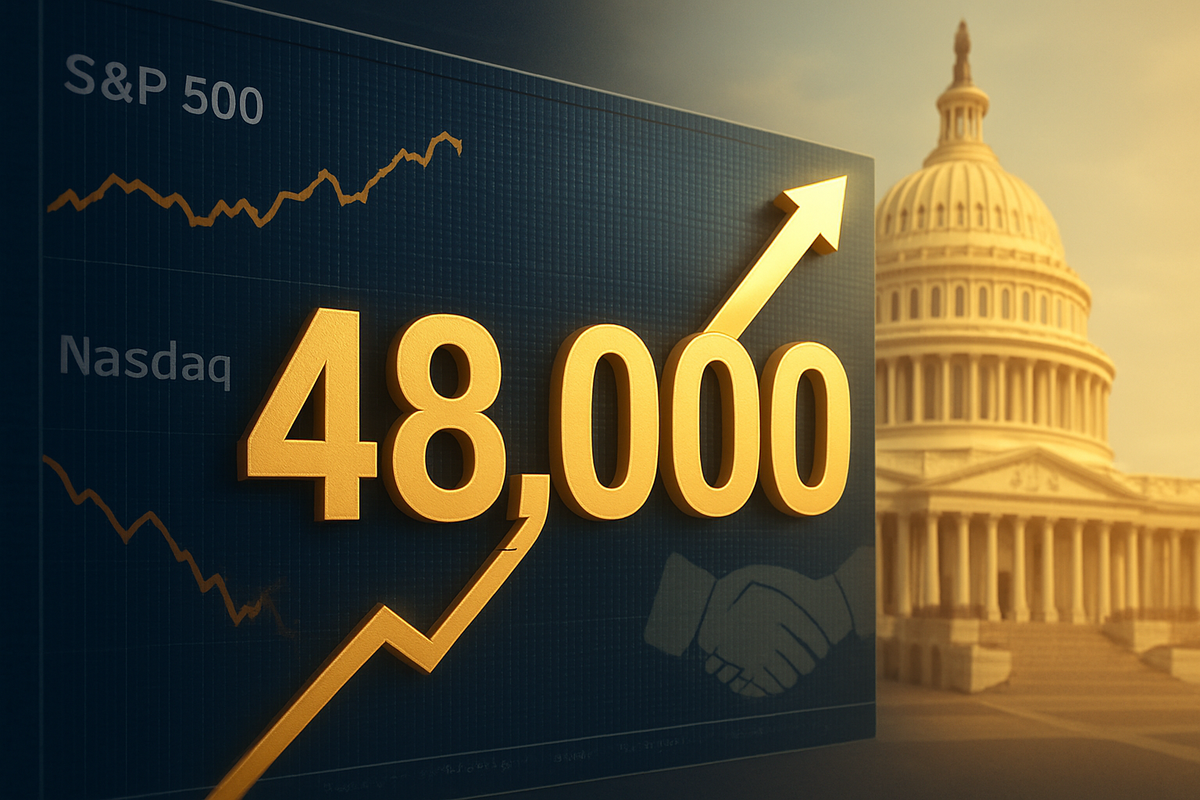
The Dow Jones Industrial Average (DJIA) made history on Wednesday, November 12, 2025, surging past the 48,000-point mark for the first time ever, gaining nearly 380 points. This significant rally was fueled by a wave of optimism surrounding the imminent resolution of a protracted U.S. government shutdown, which had cast a shadow over the economy for weeks. While the blue-chip index celebrated this unprecedented high, the broader S&P 500 (SPX) exhibited a more cautious, mixed performance, and the tech-heavy Nasdaq Composite (IXIC) notably wavered, reflecting a rotation of investor capital as the market recalibrates for a post-shutdown environment.
This historic ascent for the Dow underscores a renewed investor confidence in economic stability, with market participants eagerly anticipating the resumption of full government operations and the release of crucial economic data. The divergent performance across major indices, however, highlights an underlying shift in market dynamics, with cyclical sectors gaining favor over growth-oriented technology stocks as the immediate threat of government gridlock appears to recede. The focus now firmly rests on the final legislative steps to end what has become the longest government shutdown in U.S. history.
Detailed Market Movements and the Shutdown's Shadow
The Dow's journey past 48,000 culminated on November 12, 2025, building on a robust performance from the previous day. On November 11, 2025, the Dow had already rallied by 1.2%, or 559.33 points, to close at a record high of 47,927.96. The momentum carried into Wednesday, with the index trading up approximately 338 points (0.7%) by midday, ultimately breaking the 48,000 threshold and maintaining strong gains throughout the session. This impressive climb was in stark contrast to the S&P 500, which, after a 0.2% gain on Tuesday, slipped 0.1% on Wednesday after an early rise, indicating lingering investor caution. The Nasdaq Composite, comprising many of the market's growth and technology stocks, fared even less favorably, shedding 0.3% on Tuesday and continuing its decline on Wednesday, falling 0.5% by midday and closing down 0.25% at 23,468.30 points.
The primary catalyst for this market activity was the escalating expectation that the 43-day-long U.S. government shutdown, which had crippled various federal agencies and impacted economic sentiment, was finally nearing its conclusion. Optimism surged following the Senate's approval of legislation designed to fund the government until January 30, 2026. The widespread belief that this bill would swiftly pass the House of Representatives and receive presidential assent from Donald Trump ignited a strong demand for risk assets, particularly in sectors perceived to benefit from economic normalization.
Initial market reactions clearly indicated a significant rotation of capital. Financial and industrial stocks, often seen as bellwethers of economic health, spearheaded the rally. Investors actively moved funds away from what were increasingly perceived as overvalued technology stocks, redirecting them into these cyclical sectors. This shift reflected a renewed appetite for companies whose performance is closely tied to broader economic activity and stability. Major players in the banking sector, including Goldman Sachs (NYSE: GS), JPMorgan (NYSE: JPM), and American Express (NYSE: AXP), all hit new 52-week highs, signaling strong confidence in their future prospects post-shutdown. The bond market, which had been closed for Veterans Day, reopened with a notable fall in the yield on the 10-year Treasury note, further underscoring the market's positive response to the anticipated legislative resolution.
Companies Navigating the Market Shift and Government Reopening
The dual events of the Dow's historic high and the impending end of the government shutdown are creating a distinct landscape of winners and losers across various sectors. The Dow's surge, particularly its divergence from the Nasdaq, suggests a market rotation favoring value and cyclical stocks over high-growth technology. Financial institutions are prominent beneficiaries, with firms like Goldman Sachs (NYSE: GS), JPMorgan (NYSE: JPM), and American Express (NYSE: AXP) leading the charge, as they stand to gain from renewed economic stability and potentially favorable interest rate environments. Similarly, healthcare giants such as Merck & Co. (NYSE: MRK) and Amgen Inc. (NASDAQ: AMGN), and industrial powerhouses like Caterpillar (NYSE: CAT), GE Vernova (NYSE: GEV), GE Aerospace (NYSE: GE), and RTX (NYSE: RTX), are also seeing heightened investor interest due to their foundational roles in a recovering economy.
Conversely, the high-growth technology sector, which has dominated market gains in recent years, is experiencing a relative pullback. Companies like Nvidia (NASDAQ: NVDA) and AppLovin (NASDAQ: APP) have seen investors rotate out of their highly valued stocks, driven by concerns over inflated valuations. While some tech companies, such as AMD (NASDAQ: AMD), have seen surges due to specific drivers like optimism around AI, the broader trend indicates a cautious approach to the sector. Consumer discretionary companies, encompassing retail and leisure, may also face headwinds if consumer spending remains subdued despite broader market optimism.
The resolution of the government shutdown brings a more direct wave of relief and opportunity, particularly for those intricately linked to federal operations. Government contractors, including Lockheed Martin (NYSE: LMT), Boeing (NYSE: BA), Raytheon (NYSE: RTX), SAIC (NYSE: SAIC), CACI (NYSE: CACI), and Booz Allen Hamilton (NYSE: BAH), are poised for an immediate boost as stalled projects resume and payment delays cease. The broader technology sector, beyond the high-growth segment, is also expected to benefit from reduced policy uncertainty and the resumption of regulatory functions, including telecommunications companies reliant on FCC decisions. Additionally, small businesses, which bore the brunt of the shutdown through halted loan processing and contract delays, and the tourism industry, particularly those near national parks, are set for a much-needed recovery.
Wider Significance: A New Market Chapter and Policy Crossroads
The Dow Jones Industrial Average piercing the 48,000-point ceiling is more than just a numerical milestone; it signifies a robust economic environment, likely underpinned by sustained corporate earnings growth, potentially favorable interest rate policies, and continued advancements in transformative technologies like artificial intelligence. This sustained bull market benefits blue-chip companies across diverse sectors and often triggers a "wealth effect," encouraging increased consumer spending and business investment. Companies may also find it easier and more affordable to raise capital, fostering expansion and M&A activity, though this can also intensify competition. While round numbers are often psychological benchmarks, they reinforce positive investor sentiment, potentially leading to further inflows into equity markets.
From a policy perspective, a consistently high Dow could prompt the Federal Reserve to carefully consider its monetary policy, particularly if market strength coincides with inflationary pressures. However, in the current November 2025 context, softening labor momentum might still suggest a path toward potential rate cuts. Periods of sustained market highs can also draw increased regulatory scrutiny regarding market stability and potential bubbles, and a booming stock market typically translates to higher capital gains tax revenues, offering some fiscal relief. Historically, reaching significant Dow milestones has always been seen as a signal of broader economic health, with the increasing frequency of these benchmarks reflecting evolving market dynamics, though their inherent financial significance beyond psychology remains debated.
The resolution of the U.S. government shutdown, especially one as protracted as the 43-day impasse, carries equally profound wider significance. It immediately alleviates a major source of political and economic uncertainty, a crucial factor for business planning and investor confidence, which had dropped to a three-year low during the shutdown. The resumption of full government services—including regulatory functions, the release of critical economic data, and the processing of federal contracts and loans—will provide a much-needed boost across industries reliant on federal operations. Consumer and business sentiment, dampened by furloughs and service disruptions, is expected to rebound, aiding sectors like travel, hospitality, and retail that suffered from reduced spending.
While markets typically react positively to shutdown resolutions, often seeing a boost in equity indices, the U.S. dollar might experience some weakness as safe-haven demand diminishes. The consistent implementation of existing policies and a stable environment for future legislative action are paramount for economic growth. However, the resolution of this shutdown also sets the stage for renewed debates on fiscal responsibility and budget reforms to prevent future recurrences, potentially involving bipartisan compromise strategies. Historically, government shutdowns have had mixed, often temporary, impacts on financial markets, with the S&P 500 typically posting gains in the 12 months following a resolution. Nevertheless, longer shutdowns, like the current one, inflict more significant macroeconomic damage, with estimates suggesting each week can reduce real GDP growth by 0.1 to 0.2 percentage points on an annualized basis, resulting in billions of dollars in lost economic output, some of which may never be recovered.
What Comes Next: Navigating a Post-Shutdown, High-Market Environment
The market's immediate reaction to the government shutdown resolution is expected to be largely positive, fostering a sense of relief and stability. In the short term, historical data indicates that the S&P 500 often shows resilience and quick recoveries, potentially posting gains in the one to three months following such a resolution. The lost GDP growth incurred during the shutdown is also likely to rebound as federal operations normalize. Given the Dow's ascent to 48,000 even before the shutdown's conclusion, underlying investor confidence appears robust, setting the stage for a potential year-end rally, with sectors like financials, industrials, and energy particularly well-positioned for further gains.
Looking further ahead, the long-term outlook remains cautiously optimistic. All-time market highs do not inherently signal an imminent downturn; rather, they often precede periods of further growth, driven by fundamental factors such as corporate earnings, GDP expansion, interest rates, and inflation. Structural shifts, notably the ongoing innovation fueled by artificial intelligence, could continue to support elevated market valuations. However, the recurring nature of government shutdowns introduces an element of political risk that investors will increasingly factor into long-term strategies. Sustained growth will hinge on a stable policy environment and the continued resilience of corporate earnings.
Companies will need to adapt strategically to this dynamic environment. This involves meticulous resource allocation, prioritizing investments with the highest risk-adjusted returns, and agile portfolio management to expand into promising areas or divest from underperforming ones. Leveraging technological integration, particularly AI, to develop novel products and enhance operational efficiencies will be crucial. Maintaining robust balance sheets and operational agility will enable companies to navigate potential market volatility and capitalize on emerging opportunities. Ultimately, a steadfast focus on strong fundamentals and consistent earnings growth will be key to long-term value creation.
For emerging markets, the U.S. market's trajectory and policy decisions will have significant ripple effects. A period of U.S. economic stability and potentially accommodative Federal Reserve policy could reduce capital flight from emerging economies. Conversely, a stronger U.S. dollar, often associated with rising U.S. interest rates, could lead to capital outflows, currency depreciation, and higher borrowing costs for these nations. U.S. trade policies will also continue to influence global trade and commodity prices, impacting commodity-exporting emerging markets. While U.S. economic stability is generally beneficial, persistent political dysfunction could trigger broader risk aversion, making strong economic fundamentals and well-anchored inflation expectations critical for emerging market resilience.
Several scenarios could unfold in the coming months. A "Sustained Bull Run" remains a base case, assuming continued economic growth, robust corporate earnings, ongoing AI innovation, and a relatively stable geopolitical landscape. Alternatively, the market might experience a "Healthy Correction/Consolidation," a temporary pullback to digest significant gains and re-evaluate valuations without entering a prolonged bear market. "Increased Volatility with Sector Rotation" is also plausible, where the overall market trends upward but individual sectors see greater fluctuations as investors shift from high-growth to more defensive or value-oriented stocks. A "Soft Landing" macro environment, where the Federal Reserve successfully manages inflation without stifling growth, would be highly supportive of equities. However, the "Risk of Overvaluation and Subsequent Downturn" cannot be ignored if earnings growth fails to match elevated valuations or if unforeseen economic shocks emerge.
Comprehensive Wrap-up: A New Era of Market Dynamics
The historic achievement of the Dow Jones Industrial Average surpassing 48,000 points in November 2025, coupled with the resolution of the longest U.S. government shutdown, marks a pivotal moment for financial markets. Key takeaways from this period include the Dow's robust bullish momentum, evidenced by its 16th record close for the year, signaling underlying economic resilience. The bipartisan deal ending the 40-43 day government shutdown served as a crucial catalyst, alleviating economic uncertainty and boosting investor sentiment. This period also highlighted a notable sector rotation, with capital shifting from previously dominant, high-growth technology stocks—often associated with the "AI bull trade"—towards more stable value stocks and broader sectors like healthcare, energy, and consumer staples. Furthermore, the Federal Reserve's proactive stance, including a 25 basis point rate cut in October 2025, has fostered a "goldilocks narrative" of an economy strong enough for earnings growth yet sufficiently moderate to warrant monetary easing.
Moving forward, the market's immediate outlook is buoyed by restored government functionality and record-setting indices. However, the shutdown resolution, while a significant positive, is largely perceived as a "fragile pause" in deeper fiscal and policy divisions, rather than a definitive end. The full economic impact of the shutdown, including reductions in quarterly GDP growth and delayed federal payments, will become clearer as delayed data is released. Analysts suggest that while current bullish sentiment is strong, persistent concerns about inflation, varied GDP growth forecasts, and a softening labor market remain key variables. The ongoing shift towards value stocks indicates a maturing market cycle, where investors are increasingly prioritizing profitability and stability over speculative growth, particularly amidst discussions about potentially stretched valuations in the tech sector.
Ultimately, the Dow crossing 48,000 is a powerful symbolic milestone, underscoring the U.S. economy's enduring strength and adaptability in navigating complex political and economic landscapes. This period could signify a pivotal shift in investor psychology, moving towards a more diversified and fundamentally driven investment approach, rather than an almost exclusive focus on high-growth technology. The resolution of the longest government shutdown reinforces the market's strong preference for policy certainty, and its lasting impact might be a heightened sensitivity to political stability and fiscal responsibility in future policy debates.
Investors navigating the coming months should pay close attention to several critical indicators. The release of delayed U.S. economic data, including employment, inflation, and retail sales reports, will be paramount for understanding the economy's true trajectory and influencing the Federal Reserve's future interest rate decisions. Investors will closely monitor FOMC meetings for signals on further rate cuts, seeking data that is "weak enough to prompt a rate cut... yet not so weak as to raise concerns about an economic slowdown." The sustainability of corporate earnings growth and company guidance will also be vital. Furthermore, vigilance is required regarding AI sector valuations for signs of an overheated market and whether the rotation into value and broader market sectors gains further traction. The evolving political landscape and future fiscal debates, particularly concerning healthcare subsidies and the national debt, could reintroduce volatility. Finally, tracking consumer spending and inflation trends, along with considering diversification beyond U.S. equities into emerging markets, will be crucial for informed investment strategies.
This content is intended for informational purposes only and is not financial advice






